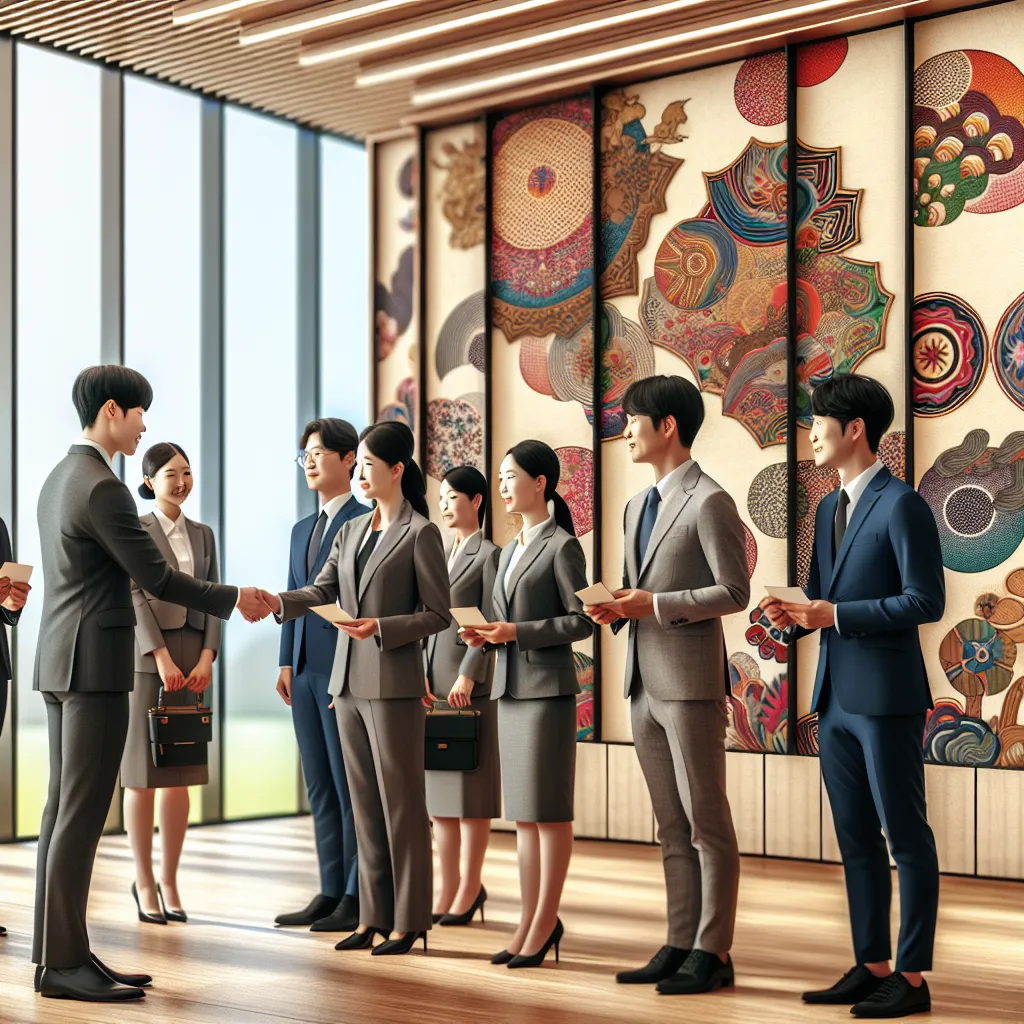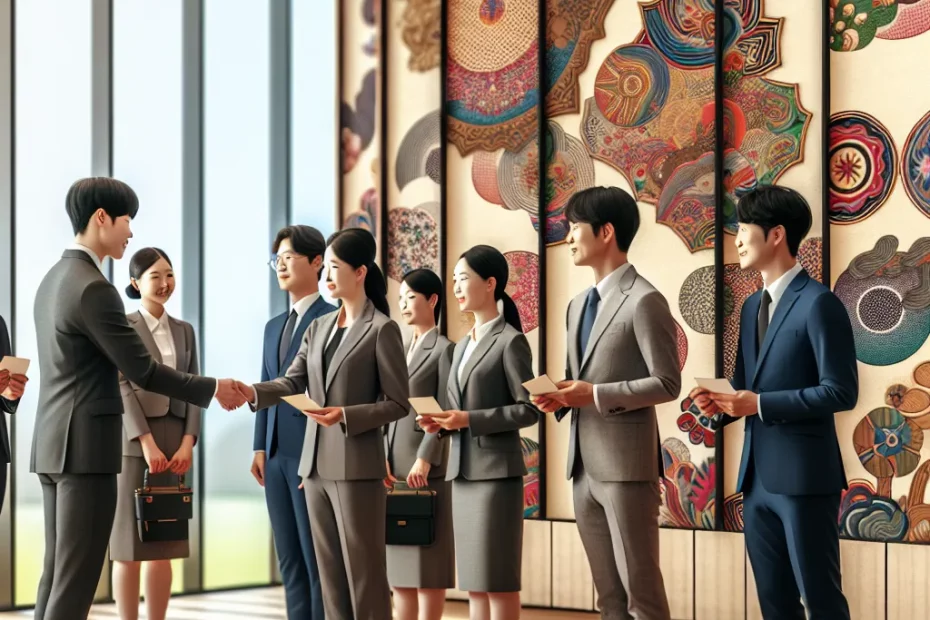As we delve into the world of Korean business culture, it’s essential to understand the nuances of business titles and proper etiquette when addressing professionals. Navigating through the hierarchy in Korean companies can be a fascinating journey, offering insights into the values and traditions that shape their corporate landscape. By grasping the intricacies of addressing Korean business professionals, we not only show respect but also pave the way for meaningful interactions and successful collaborations. Let’s explore the cultural differences in business communication and embrace the opportunity to learn and grow together in the global business arena.

Different Types of Korean Business Titles
In the Korean business world, titles are not just a formality; they carry significant weight and reflect the hierarchy within an organization. Understanding the different types of Korean business titles can help you navigate professional settings with ease. Here are some common titles you may come across:
1. 회장 (Hoejang)
회장 – This title is equivalent to the Chairman in English and is typically held by the founder or top executive of a company. The 회장 holds a position of great authority and is responsible for making major decisions.
2. 사장 (Sajang)
사장 – The 사장 is the President or CEO of a company. This title is given to the individual who oversees the overall operations of the organization and sets strategic goals for the company.
3. 이사 (Isa)
이사 – Directors in Korean companies are referred to as 이사. They play a key role in corporate governance and are responsible for overseeing specific areas of the business, such as finance, marketing, or operations.
4. 부장 (Bujang)
부장 – A 부장 is a Senior Manager or Department Head. Individuals with this title are in charge of leading a specific department within the organization and are responsible for achieving departmental goals.
5. 과장 (gwajang)
과장 – The 과장 is a Manager in Korean companies. Managers are responsible for supervising a team of employees, ensuring that tasks are completed efficiently, and reporting to higher-level executives.
6. 대리 (Daeri)
대리 – A 대리 holds the title of Assistant Manager or Supervisor. Individuals with this title often serve as a bridge between lower-level employees and upper management, providing guidance and support to their team.
Understanding these different types of Korean business titles can help you address individuals appropriately and navigate the hierarchical structure of Korean organizations effectively. Remember to show respect and deference to individuals with higher titles, as this is an important aspect of Korean business culture. 🇰🇷✨
If you have any questions about specific titles or Korean business etiquette, feel free to ask! I’m here to help you navigate the ins and outs of the Korean business world. Let’s learn and grow together in this exciting journey! 🌟
Understanding the Hierarchy in Korean Companies
Hey there, folks! Today, let’s dive into the fascinating world of Korean business titles and the intricate web of hierarchy within Korean companies. 🌟
In Korea, business titles are not just names; they represent a person’s position, authority, and status within the company. It’s crucial to understand these titles to navigate the corporate landscape effectively. 🏢
The Top of the Hierarchy: “회장” (Hoejang) – Chairman
At the top of the hierarchy, we have the “회장” (Hoejang), which translates to “Chairman.” This position holds the highest authority in the company and is usually the founder or a major shareholder. The Chairman sets the overall direction and vision for the company. 🎩
The CEO: “대표이사” (Daepyoisa) – CEO
Next in line is the “대표이사” (Daepyoisa), the CEO. The CEO is responsible for implementing the Chairman’s vision, managing day-to-day operations, and making strategic decisions. They are the face of the company to the outside world. 👔
The Executive Vice President: “상무” (Sangmu) – Executive Vice President
Moving down the hierarchy, we have the “상무” (Sangmu), who holds the position of Executive Vice President. The Sangmu oversees specific departments or divisions within the company and plays a crucial role in executing strategies. 📊
The Director: “이사” (Isa) – Director
Below the Sangmu, we find the “이사” (Isa), the Director. Directors are in charge of individual departments or teams and report to the Executive Vice President. They are responsible for ensuring that their departments meet their goals and objectives. 📈
The Manager: “부장” (Bujang) – Manager
Further down the hierarchy, we have the “부장” (Bujang), the Manager. Managers are responsible for supervising a team of employees and ensuring that day-to-day operations run smoothly. They play a vital role in implementing strategies and policies set by the higher-ups. 💼
The Team Leader: “주임” (Juim) – Team Leader
Lastly, we have the “주임” (Juim), the Team Leader. Team Leaders oversee a small group of employees and are responsible for guiding and supporting their team members to achieve their objectives. They act as a bridge between the management and the employees. 🌟
Understanding the hierarchy in Korean companies is not just about titles; it’s about understanding the dynamics, respect, and communication styles that come with each position. By grasping these nuances, you can navigate the corporate world in Korea with finesse and confidence. 🚀
So, next time you find yourself in a Korean company, remember to pay attention to the titles, show respect to those in higher positions, and embrace the unique hierarchy that defines Korean corporate culture. Fighting! 💪
Proper Etiquette for Addressing Korean Business Professionals
When it comes to addressing Korean business professionals, understanding the proper etiquette is essential for building strong relationships. In Korean business culture, titles and hierarchy play a significant role in how individuals are addressed. For example, using the appropriate title when addressing someone shows respect and acknowledges their position within the organization.
Addressing by Title and Last Name
In Korea, individuals are often addressed by their title followed by their last name. For instance, if you are speaking to a senior manager named Park Joon, you would address him as “Manager Park.” This demonstrates respect for his position and authority within the company. It is important to note that using titles is crucial in Korean business settings, as it reflects the hierarchical structure that is deeply ingrained in Korean culture.
Using Formal Language and Honorifics
Furthermore, when addressing someone of higher status or authority, it is customary to use formal language and honorifics. This shows humility and respect towards the individual, which is highly valued in Korean business culture. Using polite language and honorifics such as “님(nim)” after the person’s title or name is a common practice when speaking to superiors or clients.
Adapting to the Level of Formality
In addition to using proper titles and language, it is also important to be aware of the appropriate level of formality based on the relationship and situation. While maintaining respect and professionalism is crucial, understanding when to use formal language versus informal language can help navigate various business interactions effectively.
Overall, by demonstrating an understanding of Korean business etiquette and addressing protocols, you can establish positive relationships and effectively communicate with Korean business professionals. Remember, showing respect, using proper titles, and adapting to the level of formality required in each situation are key elements to successful business interactions in Korea! 🇰🇷✨
Navigating Cultural Differences in Business Communication
Welcome to a guide on understanding Korean business titles and addressing protocol! In the dynamic world of business, effective communication is key, especially when navigating different cultural norms and etiquettes. In South Korea, hierarchy and respect play a significant role in business interactions. Understanding how to address individuals based on their titles and the appropriate protocol can help you establish strong relationships and foster successful business partnerships. 🌟
Understanding Korean Business Titles
In Korean business culture, titles are crucial as they reflect a person’s position and authority within the organization. It is essential to address individuals using their appropriate titles to show respect and acknowledge their status. For example, using “Director Kim” or “Manager Lee” instead of just their first names demonstrates your understanding of the hierarchical structure and your willingness to adhere to it. This simple gesture can go a long way in building rapport and earning trust. 👔
Addressing Protocol in Korean Business Settings
When it comes to addressing someone in a business setting, it is common to use titles followed by the individual’s last name. For instance, “Team Leader Park” or “President Choi” are respectful ways to address colleagues or business partners. This formality emphasizes the importance of hierarchy and shows that you value the person’s position within the organization. By using the appropriate titles, you not only show respect but also indicate your understanding of Korean business customs. 📊
Proper Protocol for Greetings and Meetings
Furthermore, understanding the proper protocol for greetings and meetings is essential in Korean business culture. When greeting someone for the first time or in a formal setting, a bow is a common gesture of respect. The depth of the bow may vary based on the person’s seniority or status. Additionally, exchanging business cards, or “meishi,” is a standard practice in Korean business meetings. Presenting your card with both hands and receiving the other person’s card with a slight bow demonstrates politeness and professionalism. 🤝
In conclusion, navigating cultural differences in business communication, especially in Korean business settings, requires a nuanced understanding of titles, addressing protocol, and etiquette. By showing respect for hierarchy, using appropriate titles, and following established customs, you can effectively communicate and build strong relationships with your Korean counterparts. Remember, a little effort in understanding and adapting to cultural norms can go a long way in achieving success in the global business arena. 🚀
As we delve into the intricacies of Korean business titles and addressing protocol, it becomes evident that understanding the hierarchical structure is crucial in navigating the corporate landscape. By grasping the nuances of how titles reflect authority and seniority, we can show respect and build rapport with Korean business professionals. Remember, addressing individuals with the appropriate title signifies acknowledgment of their position and expertise, fostering positive relationships. Embracing cultural differences in communication styles leads to effective cross-cultural interactions and opens doors to new opportunities. Let’s continue to learn, adapt, and connect in the ever-evolving global business environment.
